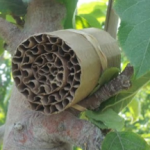By Robert Orpet, Washington State University, Department of Entomology
Studies show earwigs can suppress woolly apple aphid populations and they also feed on many other pests, including rosy apple aphid, apple aphid, codling moth larvae, and scales. Though they can damage soft fruits such as apricots, earwigs rarely cause real harm in apple orchards, where they may feed on foliage or damaged apples.
Earwig monitoring
Trap construction. You can get a rough idea of your earwig population size by using the traps described below. Each trap is made from one strip of single-walled corrugated cardboard, about 3 in. X 14 inches, rolled tightly with a rubber band (see Figure 1).
Trap deployment. Place 10-15 of these traps in the orchard block of interest. Spread them out between at least 3 different rows to cover the whole block, or focus on smaller areas as desired. For best results, place traps at least 15 feet apart and avoid the edges of the block. To place a trap, loop its rubber band around a twig or wedge the trap securely in a crotch so that the cardboard is in contact with trunk and around 2 feet off the ground. Avoid placing traps where they will be sprayed with irrigation sprinklers. Note: most earwigs will not be active until mid-May.
Interpreting results. After about two weeks, shake earwigs out of the traps into a bucket to count them. Vigorously shake the cardboard to ensure all earwigs fall out of the corrugations. Interpret the size of your population using Table 1 below. In 2014 and 2015 observations in Washington, orchards with earwig counts greater than 15 per trap tended to have lower abundance of woolly apple aphid and green apple aphid, but there were exceptions to this pattern.
Table 1. Interpretation of Earwig Trap Counts.
| Average no. of earwigs per trap | Population size |
|---|---|
| 0 | No earwigs |
| <15 | Low |
| 15-25 | Medium |
| 25-50 | High |
| 50+ | Very high, earwig utopia |
Because earwigs go through only one generation per year, earwig deaths have long term effects on the population size, and conservation strategies will produce results slowly. Earwigs begin to move underground in October where they overwinter in nests. Tillage after this time can destroy these nests, causing high winter mortality. Earwigs begin foraging and eventually abandon the nests from May to late June. To conserve earwigs, avoid the pesticides listed in Table 2 when earwigs are active. The pesticides in Table 3 are earwig-safe. If a pesticide is not listed in either table, there are no data available on its earwig safety.
Table 2. Pesticides toxic to earwigs
| Name | Trade name |
|---|---|
| Acetamiprid | Assail |
| Azadirachtin | Neemix |
| Carbaryl | Sevin |
| Chlorpyrifos | Lorsban |
| Diazinon | Diazinon |
| Imidacloprid | Provado |
| Indoxacarb | Avaunt |
| Kaolin clay | Surround |
| Lambda-cyhalothrin | Warrior |
| Phosmet | Imidan |
| Spinosad | Entrust |
| Thiacloprid | Calypso |
Table 3. Earwig-safe pesticides
| Name | Trade name |
|---|---|
| Abamectin | Agri-mek |
| Bacilllus thuringiensis | Dipel |
| Chlorantraniliprole | Altacor |
| Methoxyfenozide | Intrepid |
| Mineral oil | Various |
It may be possible capture earwigs in the traps described here and move them to other orchards to establish or augment populations. However, no scientific studies have yet been conducted to demonstrate that this will be effective.
Final notes
Many factors affect woolly apple aphid populations, so high earwig populations do not guarantee a low woolly apple aphid population, and an absence of earwigs does not necessarily to lead to aphid outbreaks.
Earwig development is related to temperature so the time periods given in this guide are only rough estimates.

